Eddies in the Marginal Ice Zone of Fram Strait and Svalbard from Spaceborne SAR Observations in Winter
Abstract
:1. Introduction
2. Materials and Methods
3. Results
3.1. Spatio-Temporal Statistics of MIZ Eddies
3.2. Ice Trapping and Melting by Eddies
3.3. Relation to Boundary Currents and Winds
4. Discussion
5. Conclusions
Author Contributions
Funding
Institutional Review Board Statement
Data Availability Statement
Conflicts of Interest
References
- Johannessen, J.A.; Johannessen, O.M.; Svendsen, E.; Shuchman, R.; Manley, T.; Campbell, W.J.; Josberger, E.G.; Sandven, S.; Gascard, J.C.; Olaussen, T.; et al. Mesoscale eddies in the Fram Strait marginal ice zone during the 1983 and 1984 Marginal Ice Zone Experiments. J. Geophys. Res. Oceans 1987, 92, 6754–6772. [Google Scholar] [CrossRef] [Green Version]
- Johannessen, O.M.; Johannessen, J.A.; Svendsen, E.; Shuchman, R.A.; Campbell, W.J.; Josberger, E. Ice-edge eddies in the Fram Strait marginal ice zone. Science 1987, 236, 427. [Google Scholar] [CrossRef]
- Shuchman, R.A.; Johannessen, O.M.; Campbell, W.J.; Lannelongue, N.; Burns, B.A.; Josberger, E.G.; Manley, T. Remote sensing of the Fram Strait marginal ice zone. Science 1987, 236, 427–439. [Google Scholar] [CrossRef]
- Wadhams, P.; Squire, V.A. An ice-water vortex at the edge of the East Greenland Current. J. Geophys. Res. 1983, 88, 2770–2780. [Google Scholar] [CrossRef]
- Biddle, L.C.; Swart, S. The observed seasonal cycle of submesoscale processes in the Antarctic marginal ice zone. J. Geophys. Res. Oceans 2020, 125, e2019JC015587. [Google Scholar] [CrossRef]
- Brenner, S.; Rainville, L.; Thomson, J.; Lee, C. The evolution of a shallow front in the Arctic marginal ice zone. Elem. Sci. Anth. 2020, 8, 17. [Google Scholar] [CrossRef]
- Kozlov, I.E.; Plotnikov, E.V.; Manucharyan, G.E. Brief Communication: Mesoscale and submesoscale dynamics in the marginal ice zone from sequential synthetic aperture radar observations. Cryosphere 2020, 14, 2941–2947. [Google Scholar] [CrossRef]
- Manucharyan, G.E.; Thompson, A.F. Submesoscale sea ice–ocean interactions in marginal ice zones. J. Geophys. Res. Oceans 2017, 122, 9455–9475. [Google Scholar] [CrossRef]
- Swart, S.; du Plessis, M.D.; Thompson, A.F.; Biddle, L.C.; Giddy, I.; Linders, T.; Mohrmann, M.; Nicholson, S.-A. Submesoscale fronts in the Antarctic marginal ice zone and their response to wind forcing. Geophys. Res. Lett. 2020, 47, e2019GL086649. [Google Scholar] [CrossRef] [Green Version]
- von Appen, W.J.; Wekerle, C.; Hehemann, L.; Schourup-Kristensen, V.; Konrad, C.; Iversen, M.H. Observations of a submesoscale cyclonic filament in the marginal ice zone. Geophys. Res. Lett. 2018, 45, 6141–6149. [Google Scholar] [CrossRef]
- Crews, L.; Sundfjord, A.; Albretsen, J.; Hattermann, T. Mesoscale eddy activity and transport in the Atlantic Water inflow region north of Svalbard. J. Geophys. Res. Oceans 2018, 123, 201–215. [Google Scholar] [CrossRef] [Green Version]
- Hattermann, T.; Isachsen, P.E.; von Appen, W.-J.; Albretsen, J.; Sundfjord, A. Eddy-driven recirculation of Atlantic Water in Fram Strait. Geophys. Res. Lett. 2016, 43, 3406–3414. [Google Scholar] [CrossRef] [Green Version]
- Wang, Q.; Koldunov, N.V.; Danilov, S.; Sidorenko, D.; Wekerle, C.; Scholz, P.; Bashmachnikov, I.L.; Jung, T. Eddy kinetic energy in the Arctic Ocean from a global simulation with a 1-km Arctic. Geophys. Res. Lett. 2020, 47, e2020GL088550. [Google Scholar] [CrossRef]
- Wekerle, C.; Wang, Q.; Von Appen, W.-J.; Danilov, S.; Schourup-Kristensen, V.; Jung, T. Eddy-resolving simulation of the Atlantic water circulation in the Fram Strait with focus on the seasonal cycle. J. Geophys. Res. Oceans 2017, 122, 8385–8405. [Google Scholar] [CrossRef]
- Wekerle, C.; Hattermann, T.; Wang, Q.; Crews, L.; von Appen, W.-J.; Danilov, S. Properties and dynamics of mesoscale eddies in Fram Strait from a comparison between two high-resolution ocean–sea ice models. Ocean Sci. 2020, 16, 1225–1246. [Google Scholar] [CrossRef]
- Atadzhanova, O.A.; Zimin, A.V.; Romanenkov, D.A.; Kozlov, I.E. Satellite radar observations of small eddies in the White, Barents and Kara Seas. Phys. Oceanogr. 2017, 2, 75–83. [Google Scholar] [CrossRef] [Green Version]
- Cole, S.T.; Toole, J.M.; Lele, R.; Timmermans, M.; Gallaher, S.G.; Stanton, T.P.; Shaw, W.J.; Hwang, B.; Maksym, T.; Wilkinson, J.P.; et al. Ice and ocean velocity in the Arctic marginal ice zone: Ice roughness and momentum transfer. Elem. Sci. Anth. 2017, 5, 55. [Google Scholar] [CrossRef] [Green Version]
- Bondevik, E. Studies of Eddies in the Marginal Ice Zone along the East Greenland Current Using Spaceborne Synthetic Aperture Radar (SAR). Master’s Thesis, The University of Bergen, Bergen, Norway, 2011; 95p. [Google Scholar]
- von Appen, W.J.V.; Schauer, U.; Hattermann, T.; Beszczynska-Möller, A. Seasonal cycle of mesoscale instability of the West Spitsbergen Current. J. Phys. Oceanogr. 2016, 46, 1231–1254. [Google Scholar] [CrossRef] [Green Version]
- Dokken, S.T.; Wahl, T. Observations of Spiral Eddies along the Norwegian Coast in ERS SAR Image; Rep. 96/01463; Norwegian Defence Research Establishment (NDRE): Kjeller, Norway, 1996; 29p. [Google Scholar]
- Karimova, S.S. Spiral eddies in the Baltic, Black and Caspian seas as seen by satellite radar data. Adv. Space Res. 2012, 50, 1107–1124. [Google Scholar] [CrossRef]
- Stuhlmacher, A.; Gade, M. Statistical Analyses of Eddies in the Western Mediterranean Sea based on Synthetic Aperture Radar Imagery. Remote Sens. Environ. 2020, 250, 112023. [Google Scholar] [CrossRef]
- Kozlov, I.E.; Artamonova, A.V.; Manucharyan, G.E.; Kubryakov, A.A. Eddies in the Western Arctic Ocean from spaceborne SAR observations over open ocean and marginal ice zones. J. Geophys. Res. Oceans 2019, 124, 6601–6616. [Google Scholar] [CrossRef] [Green Version]
- Bashmachnikov, I.L.; Kozlov, I.E.; Petrenko, L.A.; Glock, N.I.; Wekerle, C. Eddies in the North Greenland Sea and Fram Strait from satellite altimetry, SAR and high-resolution model data. J. Geophys. Res. Oceans 2020, 125, e2019JC015832. [Google Scholar] [CrossRef]
- Petrenko, L.A.; Kozlov, I.E. Properties of eddies near Svalbard and in Fram Strait from spaceborne SAR observations in summer. Sovr. Probl. DZZ Kosm. 2020, 17, 167–177. [Google Scholar] [CrossRef]
- Kozlov, I.E.; Kudryavtsev, V.N.; Zubkova, E.V.; Zimin, A.V.; Chapron, B. Characteristics of short-period internal waves in the Kara Sea inferred from satellite SAR data. Izv. Atmos. Ocean. Phys. 2015, 58, 1073–1087. [Google Scholar] [CrossRef]
- Lee, J.-S. Digital image smoothing and the sigma filter. Comput. Gr. Image Process. 1983, 24, 255–269. [Google Scholar] [CrossRef]
- Spreen, G.; Kaleschke, L.; Heygster, G. Sea ice remote sensing using AMSR-E 89 GHz channels. J. Geophys. Res. Oceans 2008, 113, 1–14. [Google Scholar] [CrossRef] [Green Version]
- Jakobsson, M.; Mayer, L.; Coakley, B.; Dowdeswell, J.A.; Forbes, B.; Fridman, S.; Hodnesdal, H.; Noormets, R.; Pedersen, R.; Rebesco, M. The International Bathymetric Chart of the Arctic Ocean (IBCAO) Version 3.0. Geophys. Res. Lett. 2012, 39, 1–6. [Google Scholar] [CrossRef] [Green Version]
- Karimova, S. Observations of asymmetric turbulent stirring in inner and marginal seas using satellite imagery. Intern. J. Remote Sens. 2017, 38, 1642–1664. [Google Scholar] [CrossRef]
- Fer, I.; Drinkwater, K. Mixing in the Barents Sea polar front near hopen in spring. J. Mar. Syst. 2014, 130, 206–218. [Google Scholar] [CrossRef]
- Marchenko, A.V.; Morozov, E.G.; Kozlov, I.E.; Frey, D.I. High-amplitude internal waves southeast of Spitsbergen. Cont. Shelf Res. 2021, 227, 104523. [Google Scholar] [CrossRef]
- Zatsepin, A.; Kubryakov, A.; Aleskerova, A.; Elkin, D.; Kukleva, O. Physical mechanisms of submesoscale eddies generation: Evidences from laboratory modeling and satellite data in the Black Sea. Ocean Dyn. 2019, 69, 253–266. [Google Scholar] [CrossRef]
- Nurser, A.J.G.; Bacon, S. The Rossby radius in the Arctic Ocean. Ocean Sci. 2014, 10, 967–975. [Google Scholar] [CrossRef] [Green Version]
- Kubryakov, A.; Stanichny, S.V. Mesoscale eddies in the Black Sea from satellite altimetry data. Oceanology 2015, 55, 56–67. [Google Scholar] [CrossRef]
- Josberger, E.G. Bottom ablation and heat transfer coefficients from the 1983 Marginal Ice Zone Experiments. J. Geophys. Res. 1987, 92, 7012–7016. [Google Scholar] [CrossRef]
- McPhee, M.G.; Maykut, G.A.; Morison, J.H. Dynamics and thermodynamics of the ice/upper ocean system in the marginal ice zone of the Greenland Sea. J. Geophys. Res. 1987, 92, 701–77031. [Google Scholar] [CrossRef]
- Mayot, N.; Matrai, P.A.; Arjona, A.; Bélanger, S.; Marchese, C.; Jaegler, T.; Ardyna, M.; Steele, M. Springtime export of Arctic sea ice influences phytoplankton production in the Greenland Sea. J. Geophys. Res. Oceans 2020, 125, e2019JC015799. [Google Scholar] [CrossRef]
- Sumata, H.; de Steur, L.; Gerland, S.; Divine, D.; Pavlova, O. Unprecedented decline of Arctic sea ice outflow in 2018. Res. Square 2021, 1–34. [Google Scholar] [CrossRef]
- Kubryakov, A.A.; Kozlov, I.E.; Manucharyan, G.E. Large mesoscale eddies in the Western Arctic Ocean from satellite altimetry measurements. J. Geophys. Res. Oceans 2021, 126, e2020JC016670. [Google Scholar] [CrossRef]
- Karimova, S.S.; Gade, M. Improved statistics of sub-mesoscale eddies in the Baltic Sea retrieved from SAR imagery. Int. J. Rem. Sens. 2016, 37, 2394–2414. [Google Scholar] [CrossRef]
- Boulze, H.; Korosov, A.; Brajard, J. Classification of Sea Ice Types in Sentinel-1 SAR Data Using Convolutional Neural Networks. Remote Sens. 2020, 12, 2165. [Google Scholar] [CrossRef]
- Park, J.-W.; Korosov, A.A.; Babiker, M.; Won, J.-S.; Hansen, M.W.; Kim, H.-C. Classification of sea ice types in Sentinel-1 synthetic aperture radar images. Cryosphere 2020, 14, 2629–2645. [Google Scholar] [CrossRef]
- Gupta, M.; Marshall, J.; Song, H.; Campin, J.-M.; Meneghello, G. Sea-ice melt driven by ice-ocean stresses on the mesoscale. J. Geophys. Res. Oceans 2020, 125, e2020JC016404. [Google Scholar] [CrossRef]

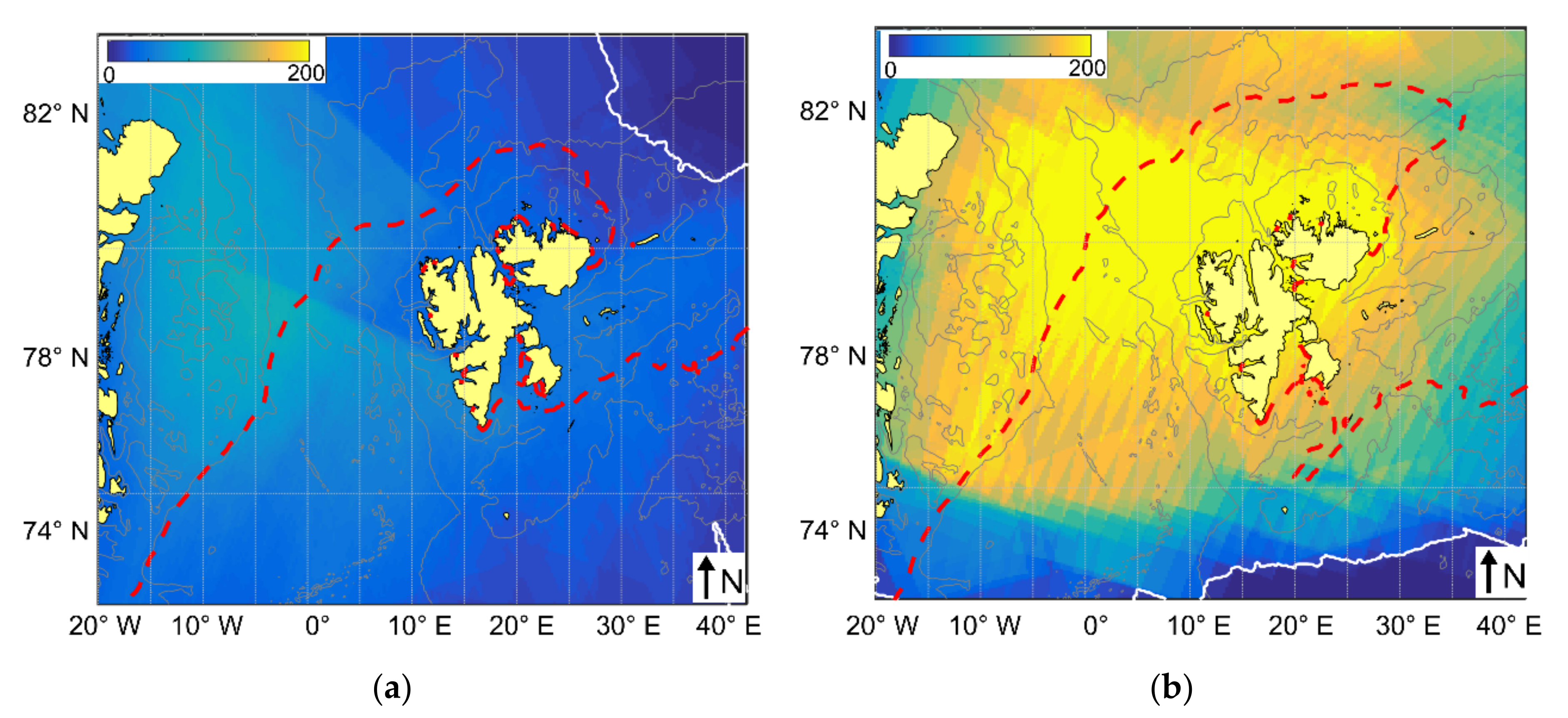

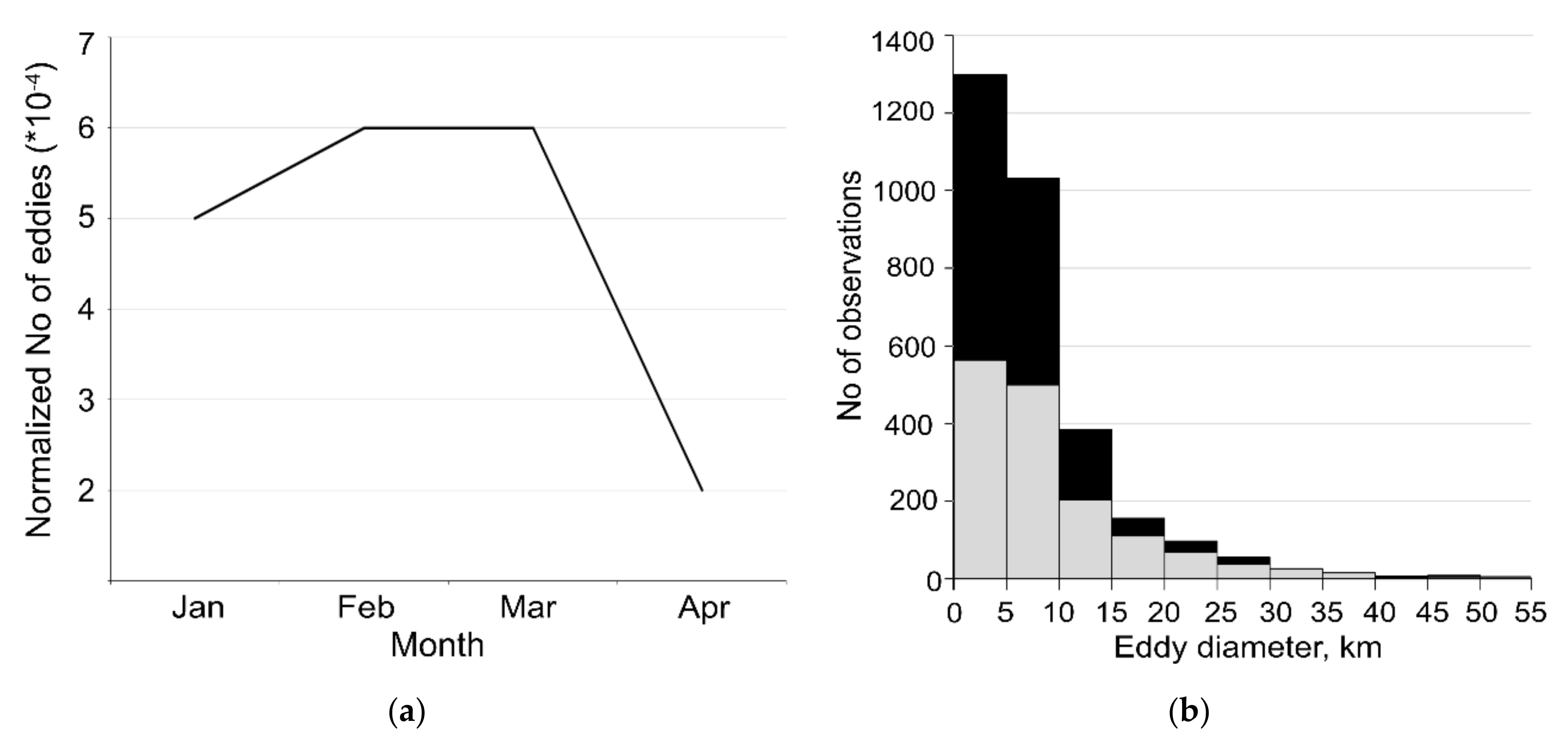


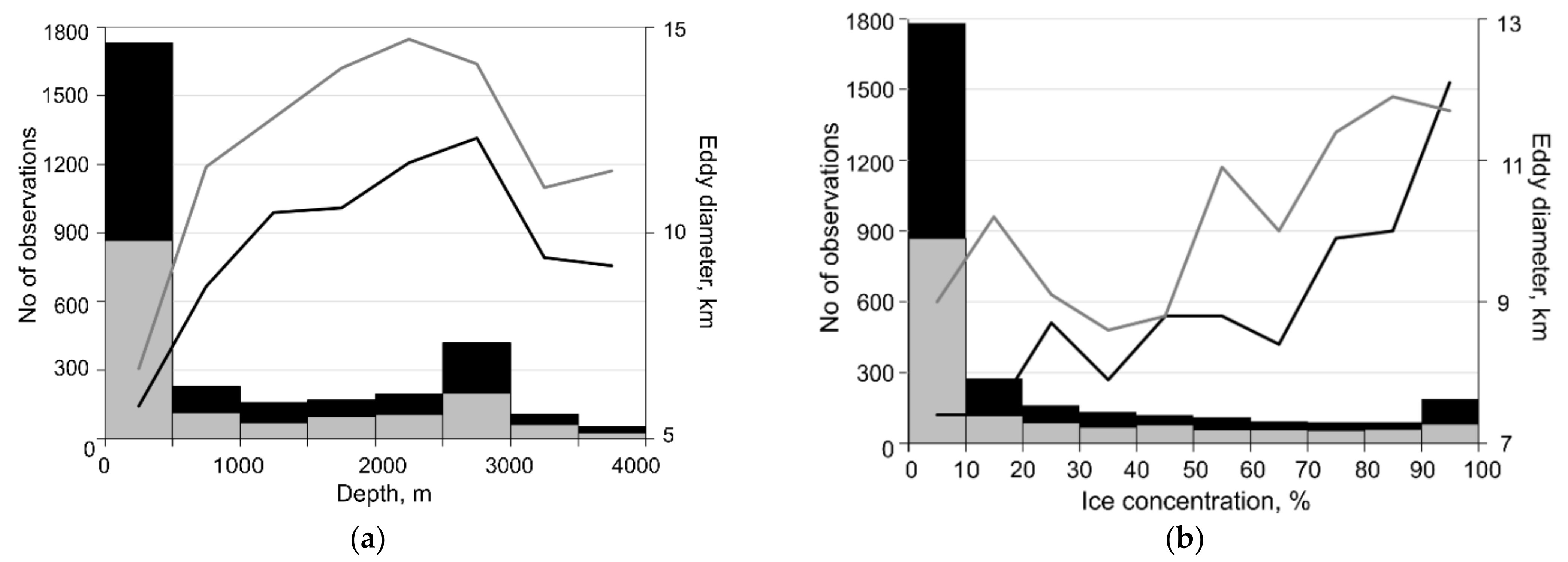
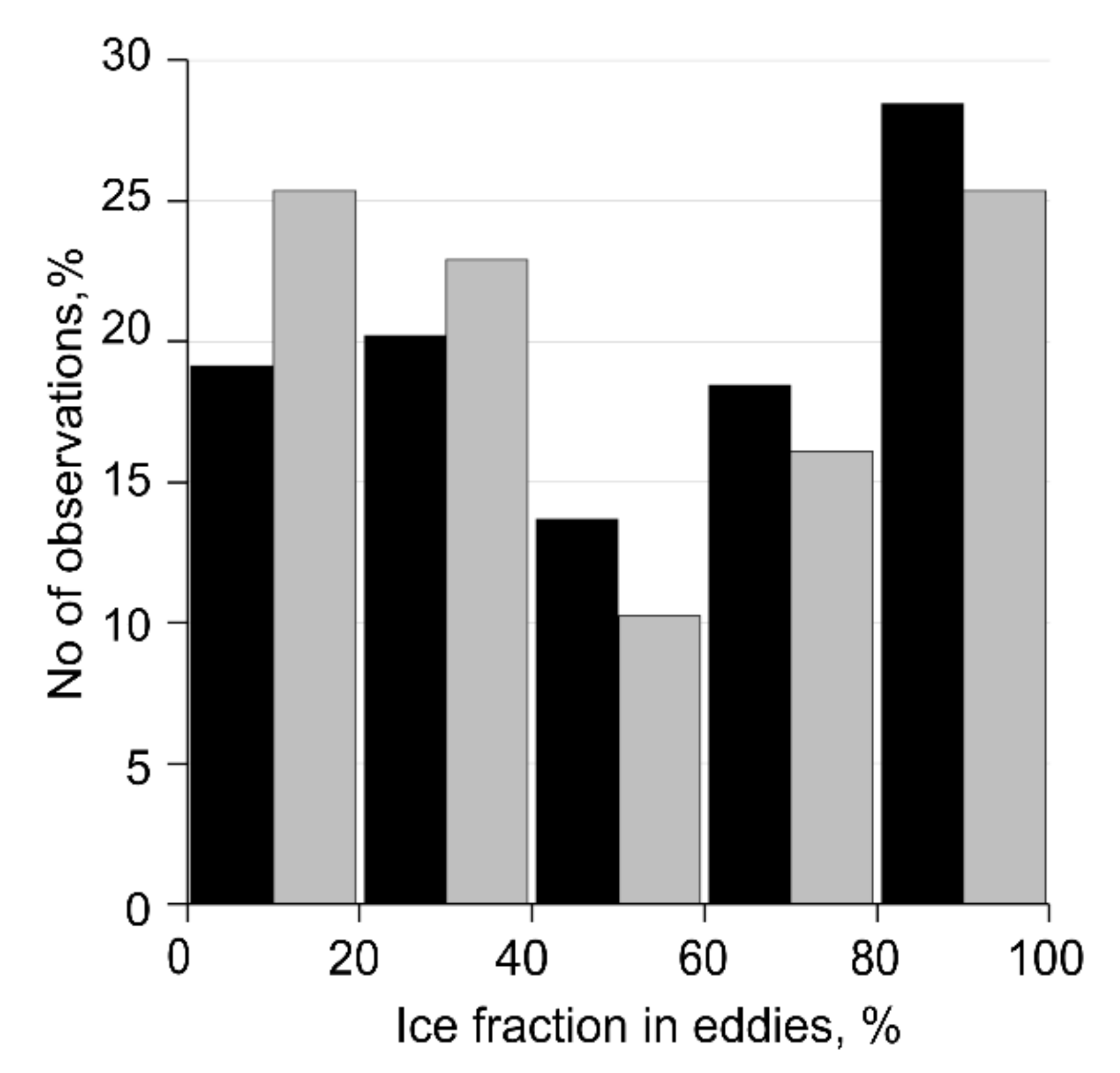

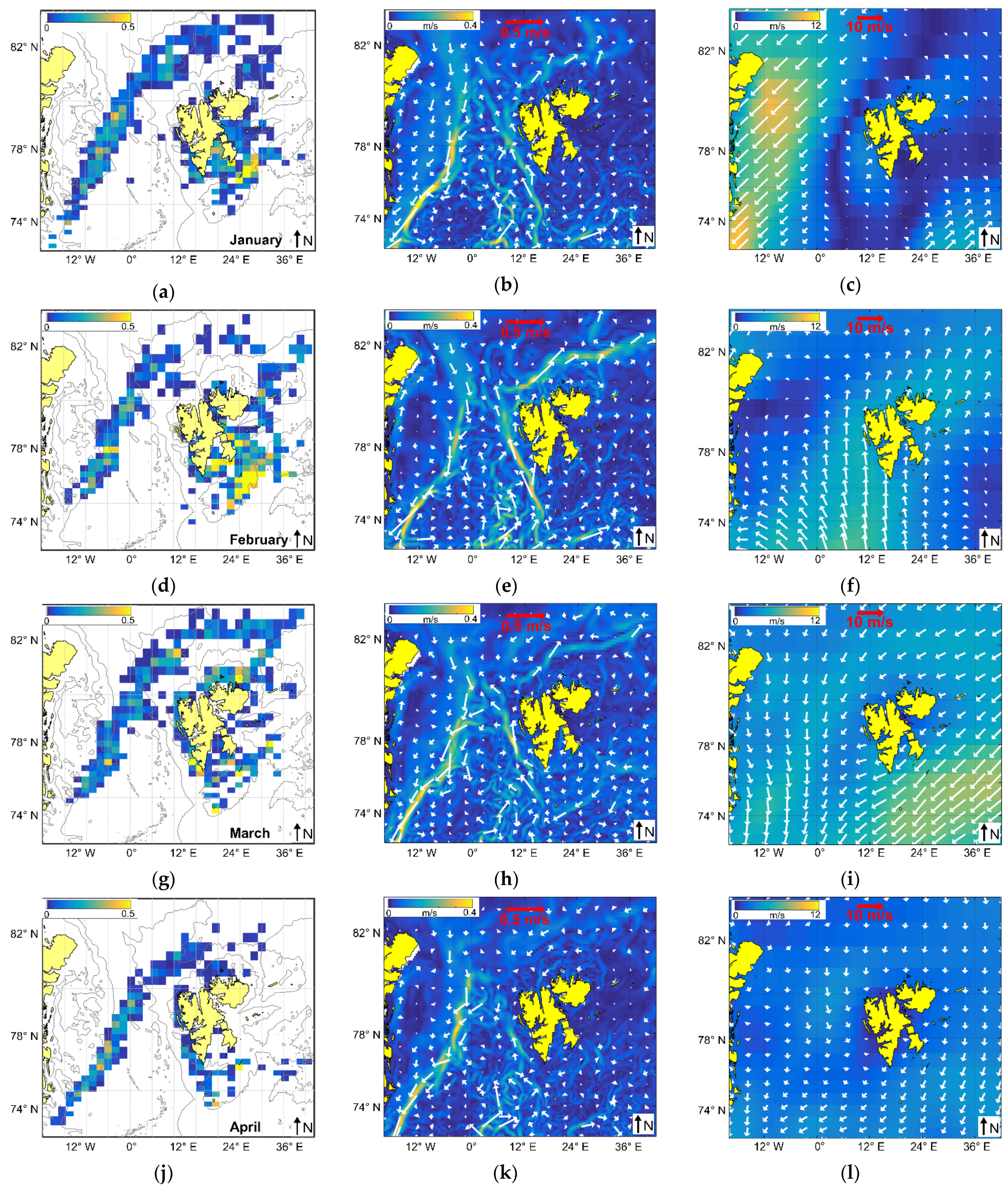
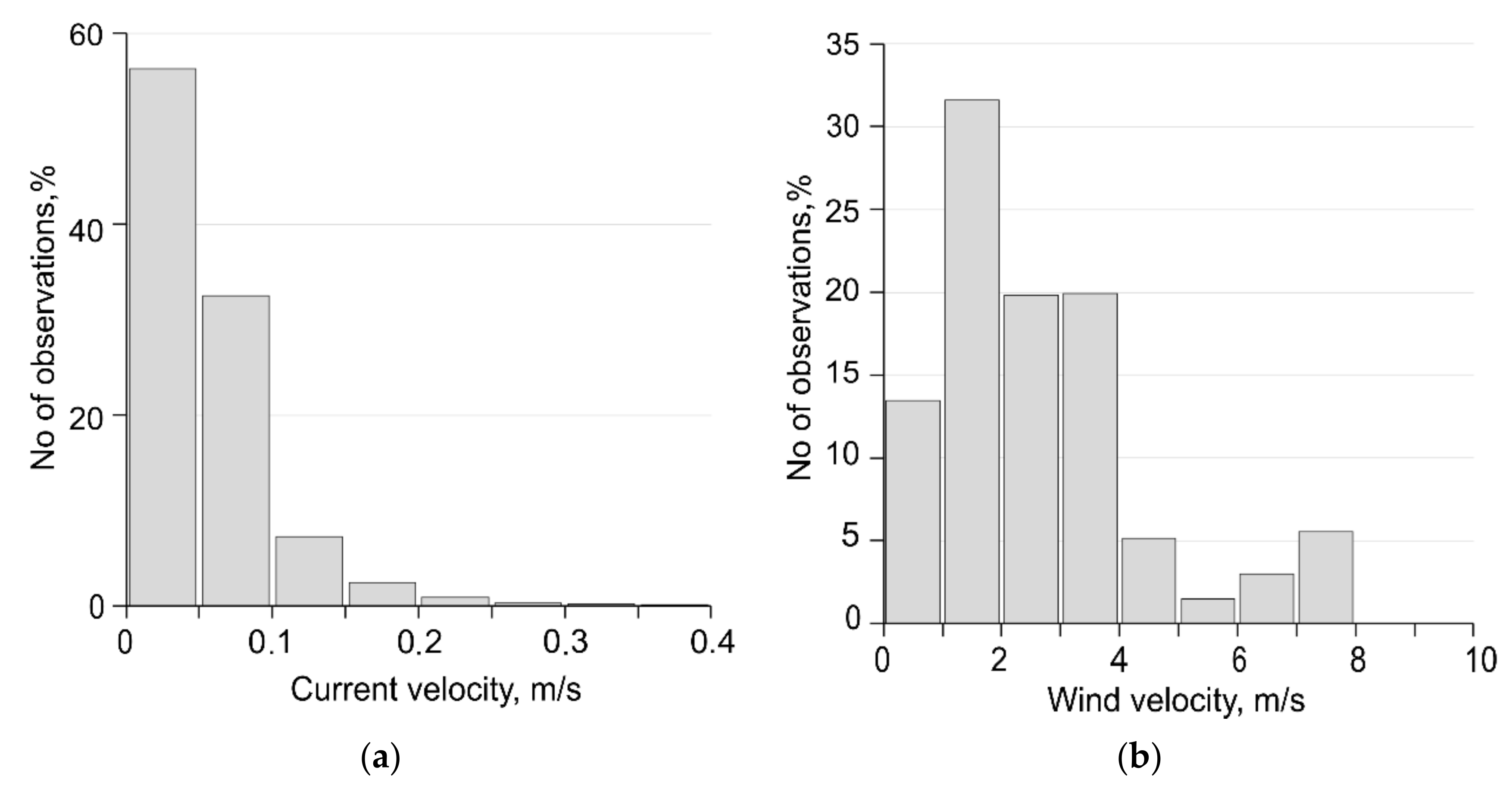
| Year | Sensor | December | January | February | March | April | Total |
|---|---|---|---|---|---|---|---|
| 2007 | ASAR | 13 | 69 | 52 | 78 | - | 212 |
| 2018 | S-1 A/B | - | 500 | 418 | 383 | 526 | 1827 |
| Month | Number of Eddies | Mean Diameter (STD), km | ||||||||||
|---|---|---|---|---|---|---|---|---|---|---|---|---|
| C | AC | SUM | C | AC | SUM | |||||||
| 2007 | 2018 | 2007 | 2018 | 2007 | 2018 | 2007 | 2018 | 2007 | 2018 | 2007 | 2018 | |
| December | 31 | - | 7 | - | 38 | - | 11.2 | - | 12.3 | - | 11.4 | - |
| January | 56 | 752 | 13 | 410 | 69 | 1162 | 8 | 7.5 | 9.4 | 9.3 | 8.3 | 8.1 |
| February | 83 | 848 | 40 | 432 | 123 | 1280 | 11.4 | 7.1 | 14 | 9.5 | 12.2 | 7.9 |
| March | 109 | 767 | 60 | 424 | 169 | 1191 | 9.7 | 8.1 | 12.8 | 8.2 | 10.8 | 8.1 |
| April | - | 430 | - | 157 | - | 587 | - | 9.3 | - | 11.3 | - | 9.9 |
| Total | 279 | 2797 | 120 | 1423 | 399 | 4220 | 10 (8.1) | 7.8 (7.2) | 12.8 (10.8) | 9.2 (8.5) | 10.9 (9.1) | 8.3 (7.7) |
Publisher’s Note: MDPI stays neutral with regard to jurisdictional claims in published maps and institutional affiliations. |
© 2021 by the authors. Licensee MDPI, Basel, Switzerland. This article is an open access article distributed under the terms and conditions of the Creative Commons Attribution (CC BY) license (https://creativecommons.org/licenses/by/4.0/).
Share and Cite
Kozlov, I.E.; Atadzhanova, O.A. Eddies in the Marginal Ice Zone of Fram Strait and Svalbard from Spaceborne SAR Observations in Winter. Remote Sens. 2022, 14, 134. https://doi.org/10.3390/rs14010134
Kozlov IE, Atadzhanova OA. Eddies in the Marginal Ice Zone of Fram Strait and Svalbard from Spaceborne SAR Observations in Winter. Remote Sensing. 2022; 14(1):134. https://doi.org/10.3390/rs14010134
Chicago/Turabian StyleKozlov, Igor E., and Oksana A. Atadzhanova. 2022. "Eddies in the Marginal Ice Zone of Fram Strait and Svalbard from Spaceborne SAR Observations in Winter" Remote Sensing 14, no. 1: 134. https://doi.org/10.3390/rs14010134





